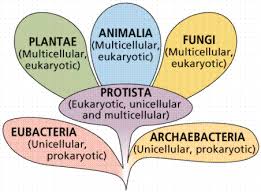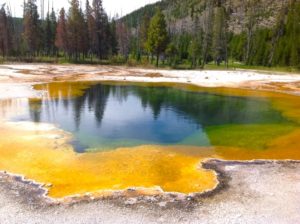Extremophiles may reveal the first life forms on an earth without oxygen.

Image: The Six Kingdoms of Life, graph; Editor’s note: Classification schemes have evolved over the years and scientists do not always agree on them.
Biologists have debated the classification of the most primitive organisms.
As a point of reference, Dr. Brock’s discovery, Thermus Aquaticus, a heat-loving extremophile, also called a thermophile, has been considered a species of archaebacteria (or ancient bacteria) that grows in steaming hot springs.
Biologists have considered other ways of classifying the organism, but there is no dispute that it is an ancient organism.
Wikipedia has described the debate over how bacteria should be classified:
Although the term bacteria traditionally included all prokaryotes, the scientific classification changed after the discovery in the 1990s that prokaryotes (prokaryotes are single-celled organisms that lack a membrane-bound nucleus [karyon], mitochondria, or any other membrane-bound organelles) consist of two very different groups of organisms that evolved from an ancient common ancestor. These evolutionary domains are called Bacteria and Archaea.
Source: Wikipedia-Bacteria.
Whatever its current precise classification may be, Thermus aquaticus has been considered a species of archaebacteria that grows in steaming hot springs.
The word archaea comes from the Ancient Greek meaning “ancient things”,[8] as the first representatives of the domain Archaea were methanogens (any of various anaerobic/non-oxygen-requiring archaea that produce methane as a metabolic byproduct), and it was assumed that their metabolism reflected Earth’s primitive atmosphere and the organism’s antiquity.
For a long time, archaea were seen as extremophiles that only exist in extreme habitats such as hot springs and salt lakes.
However, as new habitats were studied more organisms were discovered.
Extreme halophilic[9] (needing salt-rich environment) and hyperthermophilic (extreme-heat-loving] microbes[10] were also included in the Archaea.
By the end of the 20th century, archaea had been identified in non-extreme environments as well. Today, they are known to be a large and diverse group of organisms that are widely distributed in nature and are common in all habitats.[11]
This new appreciation of the importance and ubiquity of archaea came from using polymerase chain reaction (PCR) to detect prokaryotes from environmental samples (such as water or soil) by multiplying their ribosomal genes. This allows the detection and identification of organisms that have not been cultured in the laboratory.[12][13]
* * *
Archaea exhibit a great variety of chemical reactions in their metabolism and use many sources of energy. These reactions are classified into nutritional groups, depending on energy and carbon sources.
Some archaea obtain energy from inorganic compounds such as sulfur or ammonia (they are lithotrophs). These include nitrifiers, methanogens and anaerobic methane oxidisers.[97] In these reactions one compound passes electrons to another (in a redox reaction), releasing energy to fuel the cell’s activities. One compound acts as an electron donor and one as an electron acceptor. The energy released generates adenosine triphosphate (ATP) through chemiosmosis, in the same basic process that happens in the mitochondrion of eukaryotic cells.[98]
Image: Creative Commons: Morning-Glory Hot Spring, Yellowstone National Park
Archaea that grow in the hot water of the Morning Glory Hot Spring in Yellowstone National Park produce a bright [green] color [which appears to be photosynthesis creating chloryphill] [Science15 Editor’s comments in brackets].
Other groups of archaea use sunlight as a source of energy (they are phototrophs). However, [unlike the green-colored archea in the Morning Glory Hot Spring,] oxygen–generating photosynthesis does not occur in any of these organisms.[98][Science15 Editor’s comments in brackets].
Many basic metabolic pathways are shared between all forms of life; for example, archaea use a modified form of glycolysis (the Entner–Doudoroff pathway) and either a complete or partial citric acid cycle.[99] These similarities to other organisms probably reflect both early origins in the history of life and their high level of efficiency.[100]
Source: Wikipedia-Archaea.




